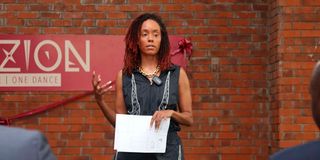Premium
Chiki Kuruka jigs all the way to the bank

Afuzion founder Chiki Kuruka gives a speech during the official launch of the curriculum on February 27, 2024.
What you need to know:
- Chiki, a trained ballet dancer, holds a degree in metaphysics and logic.
- Chiki says Afuzion takes participants through four African dance styles.
In a world where dance and wellness intersect, Chiki Kuruka emerges as a visionary figure, defying convention and reshaping the landscape of holistic healing.
A maverick in her field, Chiki’s journey from aspiring dancer to acclaimed wellness practitioner is a testament to the transformative power of movement and self-expression
Born with a fiery passion for dance and a deep-seated belief in its healing potential, Chiki embarked on a quest to merge her two great loves into a cohesive practice that transcends boundaries.
Chiki trained as a ballet dancer and has an additional degree in metaphysics and logic. She spent a lot of his career in the UK focusing specifically on mental health, dance and physical wellness.
She has also done a lot of specialist training on mental health and wellness.
Drawing from her diverse background in both dance and wellness, she developed a unique methodology that bridges the gap between physical movement and emotional well-being.

Afuzion founder Chiki Kuruka with members of her crew during the official launch of the curriculum on February 27, 2024.
This led to the launch of the e first ever certified African Dance Curriculum, Afuzion.
“Afuzion is my love letter to dance, attempting to re-educate consumers on the power and impact of dance on mental wellness, physical wellbeing and culture,” says Chiki.
Through her unconventional approach, Chiki has unlocked new dimensions of healing and self-discovery, empowering individuals to tap into their inner wisdom and unleash their true potential.
Chiki says Afuzion takes participants through four African dance styles, teaching not only the moves, but the reasons behind them, and the history and context of what was taking place in the country at the time.
With each step and each sway, she guides her students on a transformative journey towards wholeness.
She notes that starting the venture was inspired by “A want for change, and to ensure that African styles are respected and protected, and taught in a manner that better develops and builds on culture.”
The four types of dance in the curriculum include Amapiano, West African Street, Traditional Dance and Kenyan Street Styles.
Amapiano
Amapiano, a Nguni word loosely translated to “the pianos”, is a South African subgenre of house music that emerged in South Africa in the mid-2010s.
The dance is a hybrid of deep house, jazz, and lounge music characterized by synths and wide percussive basslines.
“Most of the movements in it are very lyrical and many of the dance challenges either mimic the beats, lyrics or sounds in the music. The genre is naturally high energy, so get ready to burn some serious calories, “she notes.
West Africa Street
This is a type of dance stemming from the streets of Nigeria and Ghana. The style is rooted in political demonstration, gangsters and energy, as a direct response to the globally celebrated reggae sounds of the times from artists such as Majek Fashek.
“The West Africa Dance is Inspired by Naija fusion, the style consists of Riddim bounce at it roots, and moves its way through styles developed in 2010 such as Shaku Shaku and Konto Bounce which means ‘Go Crazy’. The movements mimic real life, such as animalistic movement. The entire genre is fun, with plenty of energy and groove! So come ready to sweat!, “she adds.
Traditional dance
This dance basically focuses on tribal styles as a broad umbrella.
It’s focus is on Kenyan tribes, this genre takes a deep dive into local communities, such as the Maasai Warrior dance, Kikuyu Mugithi and Luo Ohangla.
“We step back in time to understand how our ancestors moved, and what drove those movements, embodying stories and the richness of our heritage! To say the least, our ancestors were extremely fit,” adds Chiki.
Kenyan Street Styles
“As a proudly Kenyan company, our dance journey ensures that we pay special love and attention celebrating our own styles! Manifesting as ‘Odi dance’, Kenyan street styles began to gain commercial relevance in 2019 , inspired and driven by Genge and Kupaka music, later transitioning to Gengeton and more recently UrbanTone,”says Chiki.
“As a proudly Kenyan company, our dance journey ensures that we pay special love and attention celebrating our own styles!,” she says.
This, she adds that it’s a way of joining on a journey through Kenya, in which each neighbourhood has its only Odi style, to celebrate the country.
The total cost Is Sh15, 000 for an eight week course.
She notes that Afuzion instructors are vetted through a series of both written and practical exams.
Chiki adds that the plan is focus a lot on the digital roll out, collaborating with countries across the world.





